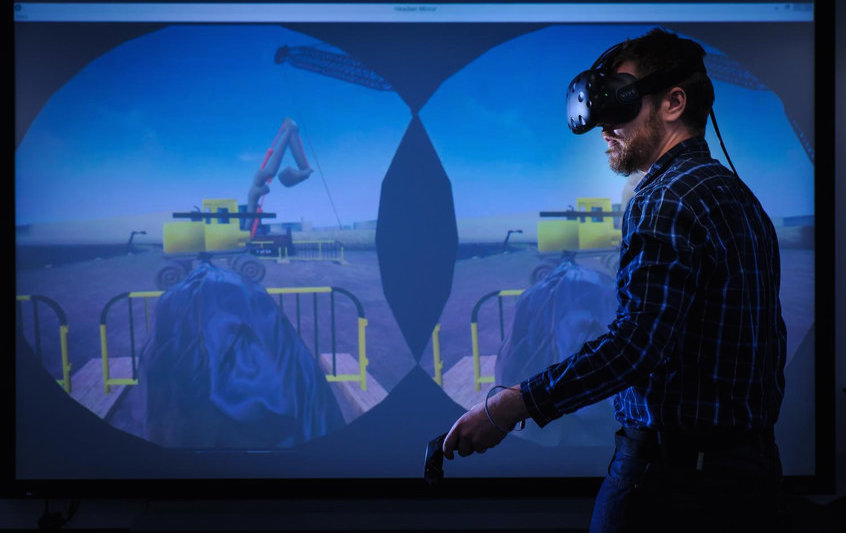German VR Safety System Lets Workers Have Accidents Before They Arrive on Site
by David Rogers. Originally on globalconstructionreview.com, October 17, 2016
Researchers at a German university have devised a way to use virtual reality (VR) technology to expose construction workers to hazardous situations before they arrive on site.
The system uses a project’s building information model (BIM) to create a virtual building site and puts a worker inside it using a VR headset and a game controller. The worker can then be exposed to simulated dangers such as being run over by trucks and or hit by crane booms, so mistakes can be learned from before construction begins.
“The beauty of it is that it can make the workers and equipment operators familiar with the actual work environment that that they will face later in reality,” said Jochen Teizer, senior lecturer at the Institute for Computing in Engineering at the Ruhr-Universitaet Bochum (RUB).
Teizer said computer games can engage workers in health and safety training better than paper-based learning.
RUB is not alone in taking this approach. Academics at the University of New South Wales have developed a ‘Situation Engine’ to generate VR site hazards, which has been tried out by Chinese companies, as well as Balfour Beatty’s Gammon subsidiary in Hong Kong.
U.S. engineering giant Bechtel last month launched a pilot scheme to use ‘immersive learning‘, with insurance companies taking an interest. In the UK a few technology companies such as VR Safety have begun offering courses in purpose-built ‘CAVEs’ (computer-automated virtual environments).
But Teizer says the industry as a whole is slow to catch on. “We have seen a tremendous latency in the understanding of what new technologies can do and what the opportunities are to engage with training and learning more effectively.”
Construction companies should ask universities to help them innovate. “If they reached out to universities they would find tremendous potential to develop their processes, incorporate useful technologies and probably find the next generation workforce, said Teizer. “As most workers and industry leaders who are 55 and older will retire relatively soon, this kind of training could allow the industry to advance on two issues at the same time – people and skills.”
He said there is a strong correlation between safety and productivity.
“If you remove all the trip hazards, people move around the site more easily,” he said. “I think that’s the selling point for the leadership in the business: as well as the important ethical reasons, funding my safety program will improve your productivity,” he said.
How it works
Wearing a VR headset, the worker performs tasks while being exposed to dangers in the virtual site before going onto the actual site. Afterwards the worker is debriefed, and tells the team how the layout of the site could be improved.
“In VR, they do things like picking up recycling bags and dumping them in a container, and suddenly the equipment comes and runs over them,” said Thomas Hilfert, a doctoral candidate who devised the method of accessing BIMs using VR headsets.
“The next time they try it, they know equipment can be coming from anywhere, and they watch out for it, so we say, okay, that’s enough learning – now we can think about changing the site layout accordingly.”
Machinery is a particular focus because, of the 60,000 deaths on construction sites around the world each year, about 25 percent involve moving parts.
Teizer, who has spent the past 15 years researching health and safety on construction sites, said that in 87 percent of these fatalities a lack of visibility meant that neither workers nor equipment operators had a chance to take avoiding action.
Teizer has personal experience of this. “All of this is based on a true fatality I observed in the U.S.,” he said. “A forklift was driving forward while the operator’s view was obstructed by the load. It ran over a manager as he was stepping out of a trailer.
“After the tragic death, they first retrained personnel to obey correct driving policies – reversing with loads – but also installed protective equipment that forced people to open a gate before they crossed a vehicle path in the plant.”
VR is one of three elements in RUB’s ‘LIFEcycle’ concept for eliminating construction site hazards.
The first is an analysis of the site as expressed by the digital model to identify hazards. The second is the VR training, which is carried out before work begins.
The third technique involves alerting site personnel in real time if they are in danger. For example, mobile equipment and workers’ clothing can be fitted with ‘wearable devices’ that warns the workers or operators from too close proximity.
Also on the RUB team is Markus Koenig, a professor of civil and environmental engineering, who is also heading a number of BIM initiatives in Germany.
Teizer has recorded a YouTube video that explains the LIFEcycle system in detail, accessible here:



